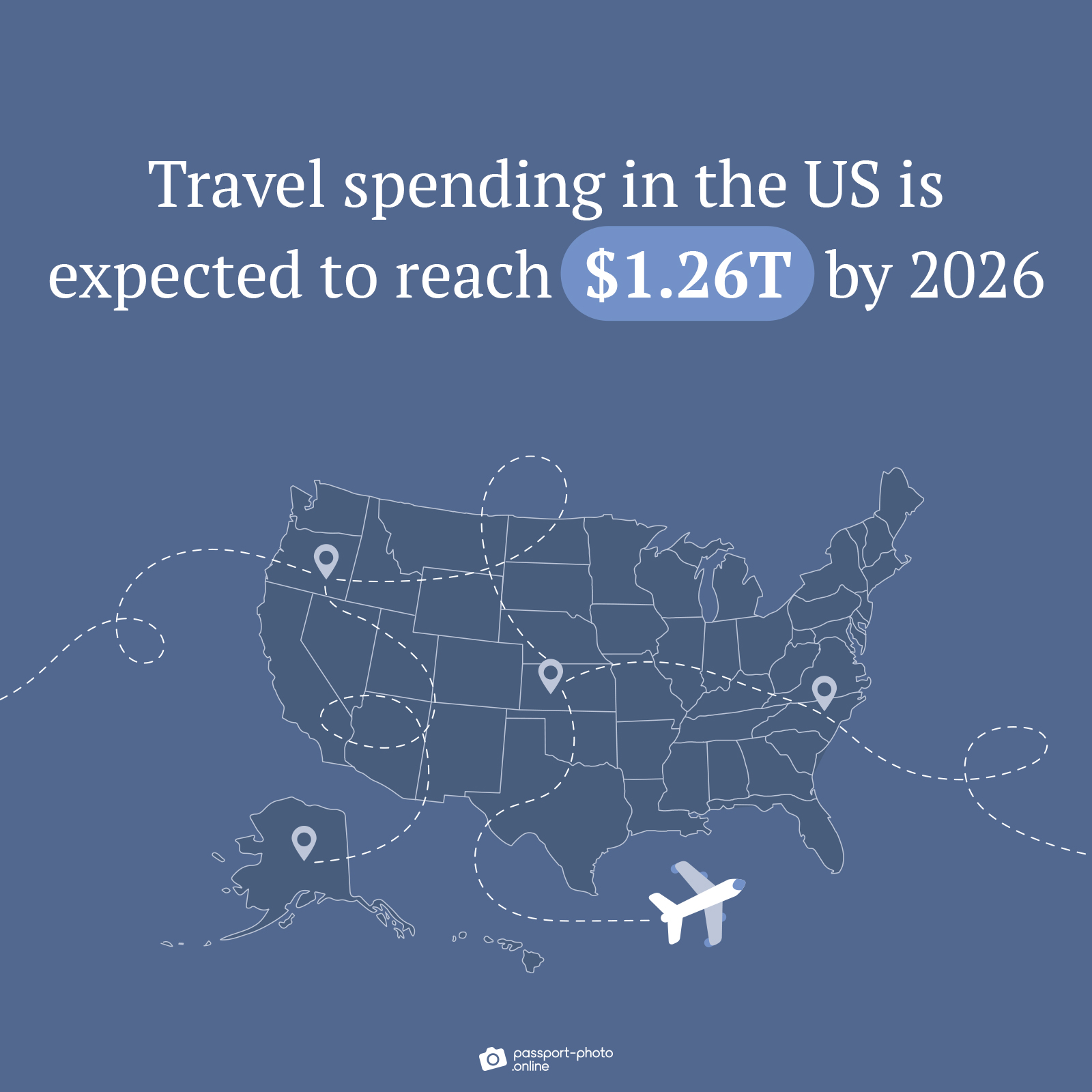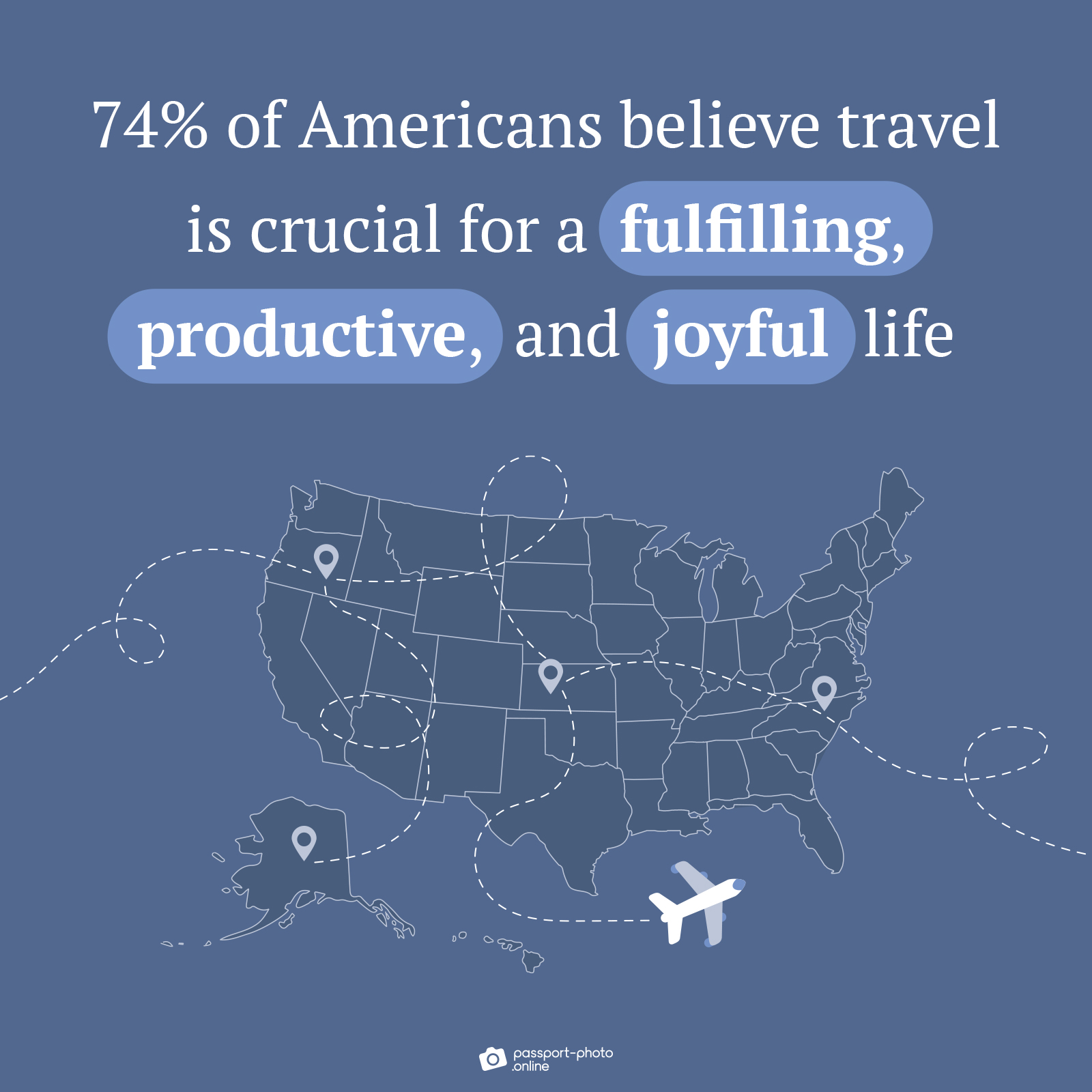Looking to understand the landscape of US tourism?
You’ve landed in the right place.
We’ve put together an exhaustive collection of the latest US tourism statistics, trends, and facts for 2025.
Top US Tourism Statistics (Editor’s Picks)
- The US tourism industry had a market size of $1.2T in 2022.
- US travelers are set to make 1.94B domestic leisure trips in 2023, with the figure rising to 2.06B by 2026.
- In 2022, US travelers made ~370M domestic business trips. By 2026, that number will likely reach 480M.
- US international travel spending hit around $109B in 2022, with a predicted surge to $198B by 2026.
- By the end of 2023, travel spending in the US is expected to reach $1.15T, increasing to $1.26T by 2026.

- Travel and tourism injected more than $1.8T into the US economy in 2022.
- In 2022, the US saw a total of 80.8M outbound tourists.
- In 2022, the United States of America welcomed 51M international visitors.
General US Tourism Stats, Facts, and Trends
- US travelers are set to make 1.94B domestic leisure trips in 2023, with the figure rising to 2.06B by 2026.
| US Domestic Leisure Trips: 2019–2021 & Forecast to 2026 | In Billions |
|---|---|
| 2019 | 1.85 |
| 2020 | 1.40 |
| 2021 | 1.77 |
| 2022 | 1.88 |
| 2023 | 1.94 |
| 2024 | 2 |
| 2025 | 2.03 |
| 2026 | 2.06 |
- In 2022, US travelers made ~370M domestic business trips. By 2026, that number will likely reach 480M.
| US Domestic Business Trips: 2019–2021 & Forecast to 2026 | In Billions |
|---|---|
| 2019 | 0.46 |
| 2020 | 0.18 |
| 2021 | 0.25 |
| 2022 | 0.37 |
| 2023 | 0.44 |
| 2024 | 0.47 |
| 2025 | 0.48 |
| 2026 | 0.48 |
- As of 2022, the US travel industry’s spending is divided into domestic leisure (71%), domestic transient business (12%), domestic group (10%), and international (10%).
- By the end of 2023, travel spending in the US is expected to reach $1.15T, increasing to $1.26T by 2026.
| Total US Travel Spending: 2019–2021 & Forecast to 2026 | In Trillion US Dollars |
|---|---|
| 2019 | 1.17 |
| 2020 | 0.72 |
| 2021 | 0.89 |
| 2022 | 1.05 |
| 2023 | 1.15 |
| 2024 | 1.21 |
| 2025 | 1.24 |
| 2026 | 1.26 |
- US domestic travel spending hit around $940B in 2022, projected to reach $1.06T by 2026.
| US Domestic Travel Spending: 2019–2021 & Forecast to 2026 | In Trillion US Dollars |
| 2019 | 0.99 |
| 2020 | 0.68 |
| 2021 | 0.84 |
| 2022 | 0.94 |
| 2023 | 1.01 |
| 2024 | 1.04 |
| 2025 | 1.05 |
| 2026 | 1.06 |
- Nearly $160B in spending was generated by transient business travelers in 2022.
- US international travel spending hit around $109B in 2022, with a predicted surge to $198B by 2026.
| US International Travel Spending: 2019–2021 & Forecast to 2026 | In Billion US Dollars |
|---|---|
| 2019 | 181 |
| 2020 | 41 |
| 2021 | 40 |
| 2022 | 109 |
| 2023 | 141 |
| 2024 | 167 |
| 2025 | 186 |
| 2026 | 198 |
- Travel and tourism injected more than $1.8T into the US economy in 2022.
| US Tourism GDP Contribution: 2019–2022 | In Trillion US Dollars |
| 2019 | 1.98 |
| 2020 | 1.04 |
| 2021 | 1.27 |
| 2022 | 1.8 |
- In 2022, meetings and events drove nearly $100B in travel spending.
- The travel industry produced $84B in state and local taxes in 2022.
- In 2022, the travel sector employed 8M Americans.
- Approximately 51M international visitors came to the US in 2022.
| Inbound International Visitors to the US: 2011–2022 | In Millions |
|---|---|
| 2011 | 63.48 |
| 2012 | 66.97 |
| 2013 | 71.64 |
| 2014 | 75.38 |
| 2015 | 77.77 |
| 2016 | 76.41 |
| 2017 | 77.19 |
| 2018 | 79.75 |
| 2019 | 79.44 |
| 2020 | 19.21 |
| 2021 | 22.10 |
| 2022 | 50.9 |
- In 2022, 53% of international arrivals to the US were from Canada and Mexico, while 47% were from other countries or overseas.
| International Arrivals to the US by Country (2022) | In Millions |
|---|---|
| Canada | 14.38 |
| Mexico | 12.53 |
| United Kingdom | 3.47 |
| Germany | 1.48 |
| France | 1.32 |
| India | 1.26 |
| Brazil | 1.22 |
| Colombia | 0.94 |
| South Korea | 0.92 |
| Spain | 0.77 |
- The number of outbound US tourists reached 80.7M in 2022.
| US Outbound Tourists: 2002–2022 | In Millions |
|---|---|
| 2002 | 58.07 |
| 2003 | 56.25 |
| 2004 | 61.81 |
| 2005 | 63.50 |
| 2006 | 63.66 |
| 2007 | 64.03 |
| 2008 | 63.56 |
| 2009 | 61.42 |
| 2010 | 60.27 |
| 2011 | 58.50 |
| 2012 | 60.72 |
| 2013 | 61.57 |
| 2014 | 68.18 |
| 2015 | 73.45 |
| 2016 | 80.23 |
| 2017 | 87.70 |
| 2018 | 92.59 |
| 2019 | 99.74 |
| 2020 | 33.50 |
| 2021 | 49.10 |
| 2022 | 80.7 |
- In 2022, over half of international departures from the US (52.8%) were to Canada and Mexico, with 47.2% to other destinations.
| US International Departures by Region/Country (2022) | In Millions |
|---|---|
| Mexico | 33.54 |
| Europe | 15.82 |
| Caribbean | 9.21 |
| Canada | 9.09 |
| Central America | 3.70 |
| Middle East | 3.12 |
| Asia | 2.65 |
| South America | 2.51 |
| Africa | 0.63 |
| Oceania | 0.46 |
- In June 2023, about 69% of US adults trusted loyalty/rewards programs, compared to 33% for ride-hailing companies.
| US Trust in Travel and Hospitality Brands by Brand Type (as of June 2023) | Share |
|---|---|
| Loyalty/rewards programs | 69% |
| Chain hotels | 67% |
| Theme parks | 64% |
| Airlines | 63% |
| Airports | 62% |
| Rental car companies | 62% |
| Travel booking sites | 60% |
| Independent boutique/hotels | 58% |
| Travel agents/advisers | 56% |
| Cruise companies | 49% |
| Vacation rental sites (e.g., Airbnb, Vrbo) | 48% |
| Ride hailing-companies | 47% |
- Generation Y travels more than any other generation (~35 days per year), closely followed by Gen Zers at 29 days per year.
- Roughly 78% of Americans believe travel boosts the economy and fosters strong connections with family and friends.
- Almost nine in 10 (86%) agree that travel is vital for educating children about other places’ history, nature, and culture.
- Three-quarters (74%) believe travel is crucial for a fulfilling, productive, and joyful life.

- Over 68% of Americans believe travel positively impacts local businesses and jobs, and 62% see traveler taxes as vital for funding public services like firefighters, police, and teachers.

Do you need passport photos? Find out more:
The State of US Hotel Industry: Rates, Occupancy, and Employment
- The hotel and motel sector in the United States reached a market size of $224.9B in 2022.
| US Hotel and Motel Sector Market Size: 2012–2022 | In Billion US Dollars |
|---|---|
| 2012 | 167.21 |
| 2013 | 175.40 |
| 2014 | 186.36 |
| 2015 | 199.50 |
| 2016 | 210.67 |
| 2017 | 212.48 |
| 2018 | 217.67 |
| 2019 | 222.26 |
| 2020 | 127 |
| 2021 | 171.10 |
| 2022 | 224.9 |
- As of 2023, the United States has 2.09M hotel jobs.
| US Hotel Jobs: 2019–2023 | In Millions |
|---|---|
| 2019 | 2.35 |
| 2020 | 1.67 |
| 2021 | 1.78 |
| 2022 | 1.95 |
| 2023 | 2.09 |
- As of June 2023, the United States hotel industry’s average daily rate (ADR) is $158.40.
| ADR in the United States: 2001 to June 2023 | In US Dollars |
|---|---|
| 2001 | 83.62 |
| 2002 | 82.53 |
| 2003 | 82.67 |
| 2004 | 86.19 |
| 2005 | 91.03 |
| 2006 | 97.84 |
| 2007 | 104.35 |
| 2008 | 107.42 |
| 2009 | 98.18 |
| 2010 | 98.23 |
| 2011 | 101.96 |
| 2012 | 106.23 |
| 2013 | 110.35 |
| 2014 | 113.42 |
| 2015 | 120.01 |
| 2016 | 123.97 |
| 2017 | 126.72 |
| 2018 | 129.83 |
| 2019 | 131.21 |
| 2020 | 103.25 |
| 2021 | 125 |
| 2022 | 148.83 |
| 2023 (June) | 158.40 |
- In 2023, the US hotel industry is projected to reach 1.3B occupied room nights.
| Hotel Room Night Demand: 2019–2023 | In Billions |
|---|---|
| 2019 | 1.29 |
| 2020 | 0.832 |
| 2021 | 1.14 |
| 2022 | 1.27 |
| 2023 | 1.30 |
- As of June 2023, hotels in the United States have an occupancy rate of 69.7%.
| Hotel Occupancy Rates in the US: 2001 to June 2023 | In % |
|---|---|
| 2001 | 59.70 |
| 2002 | 59 |
| 2003 | 59.20 |
| 2004 | 61.30 |
| 2005 | 63 |
| 2006 | 63.20 |
| 2007 | 62.80 |
| 2008 | 59.80 |
| 2009 | 54.60 |
| 2010 | 57.50 |
| 2011 | 59.90 |
| 2012 | 61.30 |
| 2013 | 62.30 |
| 2014 | 64.40 |
| 2015 | 65.60 |
| 2016 | 65.50 |
| 2017 | 65.90 |
| 2018 | 66.20 |
| 2019 | 66.10 |
| 2020 | 44 |
| 2021 | 57.60 |
| 2022 | 62.70 |
| 2023 (June) | 69.7 |
- In June 2023, the US hotel industry’s revenue per available room (RevPAR) was $110.33.
| US Hotel Industry RevPAR: 2001 to June 2023 | In US Dollars |
|---|---|
| 2001 | 49.91 |
| 2002 | 48.71 |
| 2003 | 48.92 |
| 2004 | 52.80 |
| 2005 | 57.37 |
| 2006 | 61.79 |
| 2007 | 65.57 |
| 2008 | 64.25 |
| 2009 | 53.57 |
| 2010 | 56.48 |
| 2011 | 61.07 |
| 2012 | 65.16 |
| 2013 | 68.69 |
| 2014 | 74.28 |
| 2015 | 78.67 |
| 2016 | 81.19 |
| 2017 | 83.57 |
| 2018 | 85.96 |
| 2019 | 86.76 |
| 2020 | 45.48 |
| 2021 | 72 |
| 2022 | 93.27 |
| 2023 (June) | 110.33 |
- The projected US hotel room revenue in 2023 is $197.48B, a 4.4% increase over 2022.
| Hotel Room Revenue: 2019–2023 | In Billion US Dollars |
|---|---|
| 2019 | 170.35 |
| 2020 | 86.01 |
| 2021 | 142.92 |
| 2022 | 189.07 |
| 2023 | 197.48 |
- In 2023, hotels are projected to employ nearly 2.1M people, a 7.4% increase from 2022 but still 260K fewer employees than in 2019.
| Direct Hotel Employment: 2019–2023 | In Millions |
|---|---|
| 2019 | 2.35 |
| 2020 | 1.67 |
| 2021 | 1.78 |
| 2022 | 1.95 |
| 2023 | 2.09 |
- US hotels are set to generate $46.71B in state and local taxes in 2023.
| Hotel-Generated State and Local Tax Revenue: 2019–2023 | In Billion US Dollars |
|---|---|
| 2019 | 41.11 |
| 2020 | 27.89 |
| 2021 | 36.78 |
| 2022 | 44.11 |
| 2023 | 46.71 |
Exploring the Charms: US Tourist Attractions
- The National Museum of Natural History in Washington, DC, received ~3.9M visitors in 2022, the highest number among all museums.
| Most-Visited Museums in the United States (2022) | Location | Number of Visitors in Millions |
|---|---|---|
| National Museum of Natural History | Washington, DC. | 3.90 |
| National Gallery of Art | Washington, DC. | 3.26 |
| Metropolitan Museum of Art | New York City | 3.21 |
| Museum of Modern Art | New York City | 2.19 |
| National Museum of American History | Washington, DC. | 1.80 |
| California Science Center | Los Angeles | 1.69 |
| Smithsonian American Art Museum (with Renwick Gallery) | Washington, DC. | 1.10 |
| National Museum of African American History and Culture | Washington, DC. | 1.09 |
| Huntington Library | San Marino, California | 1.04 |
| Art Institute of Chicago | Chicago | 1.04 |
- In 2022, the amusement park sector in the United States was valued at $24.1B.
| Market Size of Amusement Parks in the United States: 2011–2022 | In Billion US Dollars |
|---|---|
| 2011 | 14.34 |
| 2012 | 14.30 |
| 2013 | 15.09 |
| 2014 | 16.09 |
| 2015 | 17.88 |
| 2016 | 18.63 |
| 2017 | 19.12 |
| 2018 | 19.92 |
| 2019 | 20.68 |
| 2020 | 8.65 |
| 2021 | 12.37 |
| 2022 | 24.1 |
- In 2022, Walt Disney World’s Magic Kingdom was North America’s most-visited amusement park, drawing 17.1M guests.
| Most Visited Amusement and Theme Parks in the US (2022) | Number of Visitors in Millions |
|---|---|
| Magic Kingdom Theme Park at Walt Disney World Resort | 17.13 |
| Disneyland Park at Disneyland Resort | 16.88 |
| Universal’s Islands of Adventure | 11.03 |
| Disney’s Hollywood Studios | 10.9 |
| Universal Studios Florida | 10.75 |
An Insight into City Tourism in the US
- In 2022, Orlando made the highest direct contribution to the United States GDP from travel and tourism, amounting to ~$35.65B.
- As of January 2022, Miami has the highest average hotel room price in the country at $304.
| US Cities with the Highest Hotel Rates (as of January 2022) | In US Dollars |
|---|---|
| Miami | 304 |
| New York | 235 |
| Las Vegas | 222 |
| San Fransisco | 211 |
| Chicago | 167 |
- As of 2023, Las Vegas is the most budget-friendly city for backpackers, with an average daily cost of $97.20.
| Most Affordable Cities for Backpacking in the US by Daily Price (2023) | In US Dollars |
|---|---|
| Las Vegas | 97.20 |
| New Orleans | 102.20 |
| Los Angeles | 103.80 |
| San Francisco | 108.89 |
| Chicago | 111.00 |
| Washington DC | 111.55 |
| Miami Beach | 115.38 |
- As of 2023, Williamsburg is the most budget-friendly city to visit in the US, with an average daily price of $112.42 per person.
| Most Affordable Cities to Visit in the US by Daily Price (2023) | In US Dollars |
|---|---|
| Williamsburg | 112.42 |
| Rapid City | 116.01 |
| Virginia Beach | 125.50 |
| San Antonio | 132.12 |
| Asheville | 132.93 |
| Albuquerque | 134.61 |
| Dallas | 140.54 |
| Austin | 141.89 |
| Reno | 143.94 |
Stacking It All Up
There you have it.
A comprehensive list of US tourism statistics, facts, and trends.
If you believe your audience will be interested in any of the information we’ve provided, feel free to share it. Just remember to link back to this page as a credit to our work.
FAQ
How many tourists visit the US each year?
How many Americans travel abroad each year?
How big is the US tourism industry?
How much money do Americans spend on travel?
What age group travels the most in the US?
Sources
- AHLA, “2023 State of the Hotel Industry Report”
- Budget Your Trip, “The Cheapest Cities to Visit in North America”
- Centre Daily Times, “These 2 Pa Destinations Are among the Most-Attended Amusement Parks in North America”
- Hospitality Net, “US Hotel Performance for June 2023”
- IBISWorld, “Amusement Parks in the US – Market Size 2004–2029”
- IBISWorld, “Hotels & Motels in the US – Market Size 2005–2029”
- IBISWorld, “Tourism in the US – Market Size”
- International Trade Administration, “Travel and Tourism Research”
- Price of Travel, “Cheapest North American Cities – Backpacker Index”
- Skift, “International Travel Volume to the US in 2022 Reached 64 Percent of Pre-pandemic Level”
- Skift, “US Millennials Travel the Most but Gen Z Is on the Rise”
- Statista, “Travel and Tourism in the US – Statistics & Facts”
- The State of the Travel Industry: Essential to Our Economy. Indispensable to Our Communities. Irreplaceable as an Industry
- Trivago, “The trivago Hotel Price Index – Track Global Hotel Pricing Trends”
- US Travel Association, “Travel Forecast | Summer 2022”
- Wikipedia, “List of Most-Visited Museums in the United States”
- WTTC, “Travel & Tourism Economic Impact”
- WTTC, “Travel & Tourism Set to Inject over $2.6 Billion into the US Economy over Next Decade”
- WTTC, “WTTC Reveal Paris as the World’s Most Powerful City Destination”

As a Digital PR specialist and a member of the Society of Professional Journalists (SPJ), Max has 5+ years of writing experience.
Over the course of his career, Max’s work has garnered significant attention, with features in numerous prominent publications such as The New York Times, Forbes, Inc., Business Insider, Fast Company, Entrepreneur, BBC, TechRepublic, Glassdoor, and G2.









